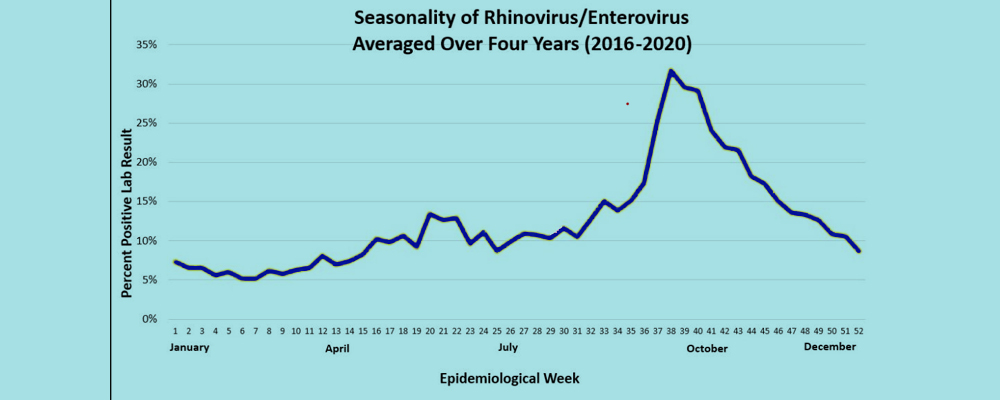Updated on February 6, 2024
Human Rhinovirus/Enterovirus is the leading cause of the common cold. In the United States, children experience an average of two rhinovirus infections per year, while adults have one. Most rhinovirus infections are moderate, but they can be serious, particularly in people with compromised immune systems, asthma, or other underlying medical conditions.
This comprehensive blog delves into the characteristics, transmission, clinical symptoms, and prospective treatment options for human rhinovirus/enterovirus.
Also read: Benefits of Clinical Research & The Importance of Clinical Trials
What Time of the Year Are People Most Likely to Become Infected?
Human rhinoviruses/enteroviruses are present all year round, however, they are most likely to be active in the early Fall and Spring. Other respiratory viruses, such as adenoviruses, influenza, and RSV, may also spread during this time.
Read more about Rhino Enterovirus, here.
The Common Cold Chronicles
- Transmission Dynamics: These viruses are transmitted in various ways, including airborne particles, fomites, and person-to-person contact. Environmental factors, such as seasonal variations and climate, have a significant impact on the incidence and prevalence of the common cold.
- Host Susceptibility: The immune response to HRV and enteroviruses is complicated with both innate and adaptive components. Vulnerable groups, such as children and the elderly, and those with impaired immune systems, are more vulnerable to severe symptoms.
Clinical Signs and Symptoms
- The Spectrum of Disease: From the common cold with its characteristic symptoms of nasal congestion, cough, and sneezing, to more severe acute respiratory infections like bronchitis and pneumonia, the clinical manifestations of HRV and enterovirus infections span a wide spectrum. Extra thoracic signs, such as gastrointestinal issues and central nervous system involvement, aggravate the clinical picture.
- Differential Diagnosis: Distinguishing between HRV and enterovirus infections requires an in-depth understanding of clinical signals and the use of laboratory diagnostic methods such as PCR and viral culture.
Read more about the symptoms of Human Rhinovirus/Enterovirus, here!
Therapeutic Approaches and Challenges
- Antivirus Strategies: The current treatment options for HRV and enterovirus infections are mostly antiviral medicines and symptomatic relief. Vaccination efforts are ongoing, but they face challenges due to the genetic diversity of the viruses.
- Overcoming Challenges: The emergence of medication resistance highlights the need for innovative antiviral approaches. Ongoing research into specific antiviral medicines, as well as advances in vaccination technology, provide visions of a more successful future for prevention.
What Complications Can a Common Cold Cause?
The common cold normally runs its course without complications. In other cases, it might extend to the chest, sinuses, or ears. The infection can then result in various conditions such as:
- Ear infection: The most common symptoms are earaches and a yellow or green discharge from the nose. This is especially common among children.
- Sinusitis: It happens when a cold persists for a long time. Symptoms include swollen and irritated sinuses.
- Asthma: This causes difficulties in breathing and/or wheezing, which can be triggered by a simple cold.
- Chest Infection: Infections can cause pneumonia and bronchitis. Symptoms include a persistent cough, shortness of breath, and coughing up mucus.
- Strep Throat: Strep is a throat infection. Symptoms include extreme soreness and sometimes coughing.
How to Protect Yourself from Human Rhinovirus/Enterovirus?
To lower the risk of contracting the rhinovirus, one can try these tips:
- Wash your hands for at least 20 seconds after you touch surfaces that have germs on them. If soap and water are not available, apply an alcohol-based hand rub or hand sanitizer.
- Avoid interacting with people who are sick.
- Avoid touching your eyes, nose, or mouth with dirty hands.
- Clean and disinfect things and surfaces regularly (for example, light switches, countertops, and doorknobs).
- Consider wearing a high-quality, form-fitting face mask. This could be especially useful in specific situations, for example, in household settings when someone is sick or in crowded places like buses and trains when respiratory disease activity is high in your area.
Read here on How to Prevent Rhino Enterovirus.
Takeaway
In the complicated realm of human rhinoviruses and enteroviruses, a seemingly benign common cold unveils its complexity. Understanding the genetic, clinical, and epidemiological characteristics of these viruses enables us to overcome their challenges more effectively.
With ongoing research, novel therapeutic strategies, and globally collaborative efforts, the effort to uncover the mysteries of these viral rulers of the common cold continues, promising a future with better preventive and management options for these widespread diseases.






